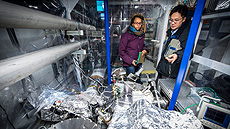Searching for the holographic universe
 |
Physicist Aaron Chou keeps the Holometer experiment — which looks for a phenomenon whose implications border on the unreal — grounded in the realities of day-to-day operations. Photo: Reidar Hahn |
The beauty of the small operation — the mom-and-pop restaurant or the do-it-yourself home repair — is that pragmatism begets creativity. The industrious individual who makes do with limited resources is compelled onto paths of ingenuity, inventing rather than following rules to address the project's peculiarities.
As project manager for the Holometer experiment at Fermilab, physicist Aaron Chou runs a show that, though grandiose in goal, is remarkably humble in setup. Operated out of a trailer by a small team with a small budget, it has the feel more of a scrappy startup than of an undertaking that could make humanity completely rethink our universe.
The experiment is based on the proposition that our familiar, three-dimensional universe is a manifestation of a two-dimensional, digitized space-time. In other words, all that we see around us is no more than a hologram of a more fundamental, lower-dimensional reality.
If this were the case, then space-time would not be smooth; instead, if you zoomed in on it far enough, you would begin to see the smallest quantum bits — much as a digital photo eventually reveals its fundamental pixels.
In 2009, the GEO600 experiment, which searches for gravitational waves emanating from black holes, was plagued by unaccountable noise. This noise could, in theory, be a telltale sign of the universe's smallest quantum bits. The Holometer experiment seeks to measure space-time with far more precision than any experiment before — and potentially observe effects from those fundamental bits.
Such an endeavor is thrilling — but also risky. Discovery would change the most basic assumptions we make about the universe. But there also might not be any holographic noise to find. So for Chou, managing the Holometer means building and operating the apparatus on the cheap — not shoddily, but with utmost economy.
Thus Chou and his team take every opportunity to make rather than purchase, to pick up rather than wait for delivery, to seize the opportunity and take that measurement when all the right people are available.
"It's kind of like solving a Rubik's cube," Chou says. "You have an overview of every aspect of the measurement that you're trying to make. You have to be able to tell the instant something doesn't look right, and tell that it conflicts with some other assumption you had. And the instant you have a conflict, you have to figure
out a way to resolve it. It's a lot of fun."
Chou is one of the experiment's 1.5 full-time staff members; a complement of students rounds out a team of 10. Although Chou is essentially the overseer, he runs the experiment from down in the trenches.
Read more
—Leah Hesla
|